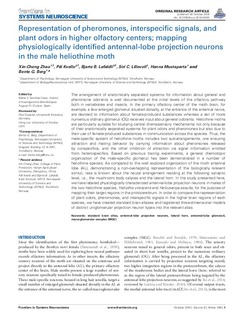| dc.contributor.author | Zhao, Xin-Cheng | |
| dc.contributor.author | Kvello, Pål | |
| dc.contributor.author | Løfaldli, Bjarte Bye | |
| dc.contributor.author | Lillevoll, Siri Corneliussen | |
| dc.contributor.author | Mustaparta, Hanna | |
| dc.contributor.author | Berg, Bente Gunnveig | |
| dc.date.accessioned | 2019-11-08T07:55:15Z | |
| dc.date.available | 2019-11-08T07:55:15Z | |
| dc.date.created | 2014-10-15T21:34:20Z | |
| dc.date.issued | 2014 | |
| dc.identifier.issn | 1662-5137 | |
| dc.identifier.uri | http://hdl.handle.net/11250/2627287 | |
| dc.description.abstract | The arrangement of anatomically separated systems for information about general and pheromone odorants is well documented at the initial levels of the olfactory pathway both in vertebrates and insects. In the primary olfactory center of the moth brain, for example, a few enlarged glomeruli situated dorsally, at the entrance of the antennal nerve, are devoted to information about female-produced substances whereas a set of more numerous ordinary glomeruli (OG) receives input about general odorants. Heliothine moths are particularly suitable for studying central chemosensory mechanisms not only because of their anatomically separated systems for plant odors and pheromones but also due to their use of female-produced substances in communication across the species. Thus, the male-specific system of heliothine moths includes two sub-arrangements, one ensuring attraction and mating behavior by carrying information about pheromones released by conspecifics, and the other inhibition of attraction via signal information emitted from heterospecifics. Based on previous tracing experiments, a general chemotopic organization of the male-specific glomeruli has been demonstrated in a number of heliothine species. As compared to the well explored organization of the moth antennal lobe (AL), demonstrating a non-overlapping representation of the biologically relevant stimuli, less is known about the neural arrangement residing at the following synaptic level, i.e., the mushroom body calyces and the lateral horn. In the study presented here, we have labeled physiologically characterized antennal-lobe projection neurons in males of the two heliothine species, Heliothis virescens and Helicoverpa assulta, for the purpose of mapping their target regions in the protocerebrum. In order to compare the representation of plant odors, pheromones, and interspecific signals in the higher brain regions of each species, we have created standard brain atlases and registered three-dimensional models of distinct uniglomerular projection neuron types into the relevant atlas. | nb_NO |
| dc.language.iso | eng | nb_NO |
| dc.publisher | Frontiers Media | nb_NO |
| dc.rights | Navngivelse 4.0 Internasjonal | * |
| dc.rights.uri | http://creativecommons.org/licenses/by/4.0/deed.no | * |
| dc.title | Representation of pheromones, interspecific signals, and plant odors in higher olfactory centers; mapping physiologically identified antennal-lobe projection neurons in the male heliothine moth | nb_NO |
| dc.type | Journal article | nb_NO |
| dc.type | Peer reviewed | nb_NO |
| dc.description.version | publishedVersion | nb_NO |
| dc.source.volume | 8 | nb_NO |
| dc.source.journal | Frontiers in Systems Neuroscience | nb_NO |
| dc.source.issue | 186 | nb_NO |
| dc.identifier.doi | 10.3389/fnsys.2014.00186 | |
| dc.identifier.cristin | 1164365 | |
| dc.description.localcode | Copyright © 2014 Zhao, Kvello, Løfaldli, Lillevoll, Mustaparta and Berg. This is an open-access article distributed under the terms of the Creative Commons Attribution License (CC BY) | nb_NO |
| cristin.unitcode | 194,67,40,0 | |
| cristin.unitcode | 194,66,10,0 | |
| cristin.unitname | Institutt for psykologi | |
| cristin.unitname | Institutt for biologi | |
| cristin.ispublished | true | |
| cristin.fulltext | original | |
| cristin.qualitycode | 1 | |

